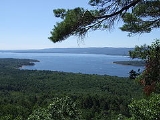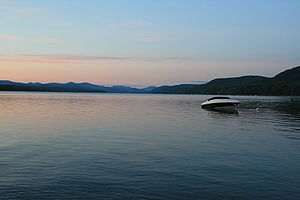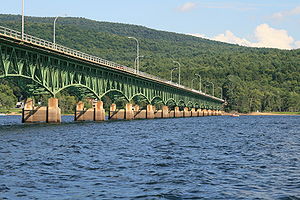
Great Sacandaga Lake
Encyclopedia

Lake
A lake is a body of relatively still fresh or salt water of considerable size, localized in a basin, that is surrounded by land. Lakes are inland and not part of the ocean and therefore are distinct from lagoons, and are larger and deeper than ponds. Lakes can be contrasted with rivers or streams,...
situated in the Adirondack Park in northern New York
New York
New York is a state in the Northeastern region of the United States. It is the nation's third most populous state. New York is bordered by New Jersey and Pennsylvania to the south, and by Connecticut, Massachusetts and Vermont to the east...
in the United States
United States
The United States of America is a federal constitutional republic comprising fifty states and a federal district...
. The word Sacandaga means "Land of the Waving Grass" in the local native language. The lake is located in the northern parts of Fulton County
Fulton County, New York
Fulton County is a county located in the U.S. state of New York. As of the 2010 census, the population was 55,531. Its name is in honor of Robert Fulton, who is widely credited with developing the first commercially successful steamboat...
and Saratoga County
Saratoga County, New York
Saratoga County is a county located in the U.S. state of New York. As of the 2010 census, the population was 219,607. It is part of the Albany-Schenectady-Troy Metropolitan Statistical Area. The county seat is Ballston Spa...
near the south border of the Adirondack Park. A small part of it also extends northward into southern Hamilton County
Hamilton County, New York
Hamilton County is a county located in the U.S. state of New York. It is named after Alexander Hamilton, the only member of the New York State delegation who signed the United States Constitution in 1787 and later the first United States Secretary of the Treasury. Its county seat is Lake Pleasant...
. The broader, south end of the lake is northeast of the City of Johnstown
Johnstown (city), New York
Johnstown is a city and the county seat of Fulton County in the U.S. state of New York. As of the 2000 Census, the city had population of 8,511. Recent estimates put the figure closer to 8,100. The city was named by its founder, Sir William Johnson after his son John Johnson...
and the City of Gloversville
Gloversville, New York
Gloversville is a city in Fulton County, New York, that was once the hub of America's glovemaking industry with over two hundred manufacturers in Gloversville and Johnstown. In 2000, Gloversville had a population of 15,413. Ten years later, the population had increased to 15,665- History :The...
.
Like many of the other lakes in the Adirondack region of northern New York, Great Sacandaga Lake is a reservoir
Reservoir
A reservoir , artificial lake or dam is used to store water.Reservoirs may be created in river valleys by the construction of a dam or may be built by excavation in the ground or by conventional construction techniques such as brickwork or cast concrete.The term reservoir may also be used to...
. The original lake was greatly enlarged by a dam on the Sacandaga River
Sacandaga River
The Sacandaga River is a river in the northern part of New York in the United States. Its name comes from the Native American Sa-chen-da'-ga, meaning "overflowed lands"....
at the northeast end of the lake. The primary purpose for the creation of the reservoir was to control flooding on the Hudson River
Hudson River
The Hudson is a river that flows from north to south through eastern New York. The highest official source is at Lake Tear of the Clouds, on the slopes of Mount Marcy in the Adirondack Mountains. The river itself officially begins in Henderson Lake in Newcomb, New York...
and the Sacandaga River.
History

Albany, New York
Albany is the capital city of the U.S. state of New York, the seat of Albany County, and the central city of New York's Capital District. Roughly north of New York City, Albany sits on the west bank of the Hudson River, about south of its confluence with the Mohawk River...
, was there a serious and concerted effort by the state to explore flood control. A public benefit corporation
Public benefit corporation
A public-benefit corporation is a public corporation chartered by a state designed to perform some public benefit.A public authority is a type of public-benefit corporation that takes on a more bureaucratic role, such as the maintenance of public infrastructure, that often has broad powers to...
was established to study the feasibility of the dam and later adopted a resolution proposing the dam in 1924. The dam was constructed by 1930 at Conklingville in the Town of Hadley
Day, New York
Day is a town in Saratoga County, New York, United States. The population was 920 at the 2000 census. The town is named after Eliphaz Day, a noted lumberman.The Town of Day is in the northwest part of the county and is northeast of Amsterdam....
, Saratoga County. Land speculation flourished as the plan to control the river and flood a large expanse of land leaked out. Many people chose to remove houses and buildings to new sites outside of the flood zone. Anything left behind as the dam neared completion was burned. However some structures remained standing as well as railroad with an abandoned aging train (now at the bottom of the lake). The new body of water was called a reservoir for many years, but after the middle of the 20th Century, the term "lake" became preferred. The reservoir is managed by the Hudson River Black River Regulating District.
Today, the local businesses benefit not only from the flood protection provided by the lake, but also from the tourist attraction and its economy that the lake has created in the area. People come from many local cities and towns to visit the lake for recreation, or to stay in their summer camps on the lake. Public access to the lake is via the many public boat launches, and public beaches; plus the campgrounds that are located on the shores of the lake.
Although the lake and some lands surrounding it are owned by New York State
New York
New York is a state in the Northeastern region of the United States. It is the nation's third most populous state. New York is bordered by New Jersey and Pennsylvania to the south, and by Connecticut, Massachusetts and Vermont to the east...
, no public money is used to manage the reservoir. Approximately 70% of the District's revenues come from lease agreements with electrical power companies who run the hydroelectric turbines in the dam.
Located on the south shore is the David Rayfiel House
David Rayfiel House
David Rayfiel House, also known as The Sacandaga Glass House or "Shelter for David Rayfiel," is a historic home located at Day in Saratoga County, New York. It was built in 1958 on the southern banks of Great Sacandaga Lake in the foothills of the Adirondack Mountains. It is a 1 1/2-story Modern...
, listed on the National Register of Historic Places
National Register of Historic Places
The National Register of Historic Places is the United States government's official list of districts, sites, buildings, structures, and objects deemed worthy of preservation...
in 2009.
The Northern Pike
Northern Pike
The northern pike , is a species of carnivorous fish of the genus Esox...
that is recognized as the North America
North America
North America is a continent wholly within the Northern Hemisphere and almost wholly within the Western Hemisphere. It is also considered a northern subcontinent of the Americas...
n record fish of that species
Species
In biology, a species is one of the basic units of biological classification and a taxonomic rank. A species is often defined as a group of organisms capable of interbreeding and producing fertile offspring. While in many cases this definition is adequate, more precise or differing measures are...
at 46 lbs. 2 oz (20.9 Kg), was caught in the reservoir on September 15, 1940 by Peter Dubuc.
Operation
Hudson River-Black River Regulating District- Location: Lat 43°18'57", long 73°55'39" (North American Datum of 1927), Saratoga County, NY, Hydrologic Unit 02020002, 800 ft upstream from right end of Conklingville Dam on Sacandaga River at Conklingville.
- Period of record: January 1930 to current year. Prior to October 1969, published as "Sacandaga Reservoir at Conklingville".
- Gage: Water-stage recorder. Datum of gage is NGVD of 1929, adjustment of 1912.
See also
- List of reservoirs and dams in New York
- The Flying HeadThe Flying HeadThe Flying Head, or Ko nea rau neh neh, is a spiritual being within the traditional belief systems of the Iroquois people."The Great God hath sent us signs in the sky we have heard uncommon noise in the heavens and have seen HEADS fall down upon the earth" Speech of Tahayadoris a Mohawk sachem at...
(a Legend of Sacandaga Lake)

